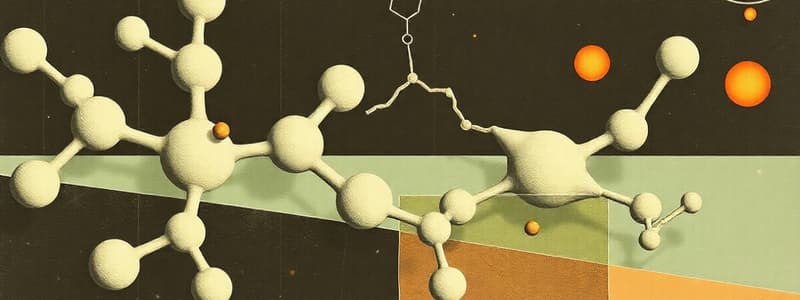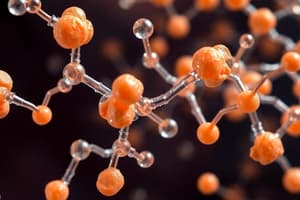Podcast
Questions and Answers
Which type of carbohydrate is made up of two monosaccharides?
Which type of carbohydrate is made up of two monosaccharides?
- Disaccharide (correct)
- Polysaccharide
- Monosaccharide
- Complex Carbohydrate
What is the primary structural component of triglycerides?
What is the primary structural component of triglycerides?
- Amino acids and fatty acids
- Fatty acids and glycerol (correct)
- Phosphate group and fatty acids
- Steroid and sugars
What type of fatty acid contains no double bonds?
What type of fatty acid contains no double bonds?
- Polyunsaturated fatty acid
- Saturated fatty acid (correct)
- Trans fatty acid
- Monounsaturated fatty acid
Which of the following is a function of collagen?
Which of the following is a function of collagen?
Which of the following best describes the role of RNA?
Which of the following best describes the role of RNA?
Which of these structures is characteristic of nucleotides?
Which of these structures is characteristic of nucleotides?
What process involves copying a DNA sequence to make RNA?
What process involves copying a DNA sequence to make RNA?
What type of bond predominantly stabilizes the secondary structure of proteins?
What type of bond predominantly stabilizes the secondary structure of proteins?
Which of the following is a characteristic feature of phospholipids?
Which of the following is a characteristic feature of phospholipids?
What is reverse transcription?
What is reverse transcription?
Flashcards
Biological Macromolecules
Biological Macromolecules
Large, complex molecules essential for life, composed of smaller subunits called monomers.
Monomers
Monomers
The repeating structural units that make up polymers.
Polymers
Polymers
Large molecules made up of repeating subunits (monomers).
Carbohydrates
Carbohydrates
Signup and view all the flashcards
Monosaccharides
Monosaccharides
Signup and view all the flashcards
Disaccharides
Disaccharides
Signup and view all the flashcards
Polysaccharides
Polysaccharides
Signup and view all the flashcards
Lipids
Lipids
Signup and view all the flashcards
Proteins
Proteins
Signup and view all the flashcards
Amino Acids
Amino Acids
Signup and view all the flashcards
Study Notes
Biological Macromolecules
- Definition: Large, organic molecules crucial for life.
- Monomer: Small, repeating units ("building blocks") that combine to form polymers.
- Polymer: Larger molecules made up of repeating monomer units.
Types of Macromolecules
Carbohydrates (CHO)
- Composition: Primarily carbon, hydrogen, and oxygen.
- Simple Carbohydrates:
- Monosaccharides: Single sugar units (e.g., glucose, fructose, galactose); cannot be broken down further.
- Disaccharides: Two monosaccharides bonded together (e.g., sucrose, lactose, maltose).
- Complex Carbohydrates (Polysaccharides): Three or more monosaccharides linked together (e.g., starch, glycogen, fiber).
Lipids (CHO)
- Characteristics: Mostly insoluble in water, soluble in non-polar solvents.
- Composition: Fatty acids and glycerol.
- Types of Fatty Acids:
- Saturated: No double bonds, straight chain, solid at room temperature.
- Trans: One or more double bonds, straight chain, semi-solid/solid at room temperature.
- Monounsaturated: One double bond (cis configuration), bent chain, liquid at room temperature.
- Polyunsaturated: Multiple double bonds (cis configuration), highly bent chain, liquid at room temperature.
- Triglycerides: Glycerol + 3 fatty acids; primary energy storage.
- Phospholipids: 2 fatty acids + phosphate group + glycerol; major component of cell membranes.
- Steroids: 4 ring structure; impact membrane fluidity and act as hormones.
- Waxes: Alcohol chain + fatty acid chain; prevent water loss in plants.
Proteins (CHON)
- Composition: Carbon, hydrogen, oxygen, nitrogen, and sometimes sulfur.
- Structure: Chains of amino acids (polypeptides).
- Primary Structure: Sequence of amino acids.
- Secondary Structure: Localized folding (alpha-helix, beta-sheet).
- Tertiary Structure: Overall 3D shape of polypeptide chain.
- Quaternary Structure: Multiple polypeptide chains interacting.
- Functions: Enzymes (e.g., amylase), hormones (e.g., insulin), structural components (e.g., collagen, keratin).
Amino Acids (CHONP)
- Definition: Building blocks of proteins.
- Note: Some amino acids are essential (must be obtained from diet).
Nucleic Acids
- Definition: Essential for genetic information storage and expression in all cells (and viruses).
- Composition: Nucleotides (nitrogenous base + pentose sugar + phosphate group).
DNA (Deoxyribonucleic Acid)
- Function: Stores genetic code for building and maintaining an organism, hereditary information, dictates protein synthesis.
- Role in Protein Synthesis: Guides the assembly of amino acids into proteins by providing instructions.
RNA (Ribonucleic Acid)
- Function: Carries genetic instructions from nucleus (DNA) to cytoplasm, helps ribosomes select amino acids, and controls gene expression.
Central Dogma
- Description: The flow of genetic information in living organisms: DNA → RNA → Protein.
- Transcription: DNA sequence copied into RNA molecule.
- Translation: RNA's genetic code decoded into the sequence of amino acids in a protein.
- Exceptions: RNA splicing, alternative splicing, epigenetic modifications, reverse transcription.
Studying That Suits You
Use AI to generate personalized quizzes and flashcards to suit your learning preferences.




